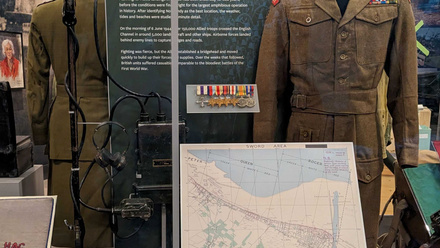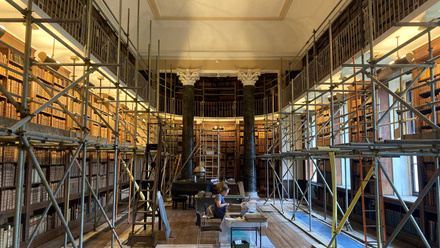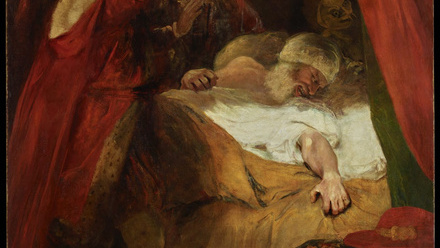When thinking of artworks most in need of conservation care, contemporary art may not be the first choice. However, whilst these artworks have been created recently, many are rapidly deteriorating. Contemporary artworks are incredibly complex, and conservators must face unique challenges around obsolescence, ethics, and artist involvement.
The materials used in contemporary art are varied, with many degrading at a high rate. Some materials used by artists may have only been developed in the past century, so tried and tested methods to treat them often don’t exist.
In addition, the meaning of contemporary art stretches beyond the material it consists of. For example, original components of a technological artwork may be replaced or updated in order to keep the artwork functioning. Ethical issues such as this are common in contemporary art conservation.
These factors highlight why traditional techniques and methods may not apply and why contemporary art conservation is important as its own specialism. So, what does contemporary art conservation entail and how does it differ from other specialisations?
1. Materials used are unconventional
Contemporary artists use a vast array of materials which differ from more traditional artists. Synthetic materials, electronic media, food items, digital components, and found objects are all examples of materials that the contemporary art conservator cares for. These materials require different environmental conditions, degrade at different rates and will require different methods for treatment.
Yet, sometimes many of these contrasting materials can be found within one artwork. Because of this, traditional methods and approaches might not be best suited. Contemporary art conservators must think of novel ways to deal with the sheer variety of materials.
Collaboration with material specialists is common when condition checking and conserving more unique works. Neon experts, glass specialists and electricians are just some of the many experts that a contemporary art conservator may consult with.
2. Artworks can be hazardous
An important part of being a contemporary art conservator is keeping up to date on all relevant training associated with various hazardous materials artists are working with.
Hazardous substances can be present within both traditional and contemporary artworks. Lead white – a typical pigment encountered by painting conservators, can cause lead poisoning. But naturally, contemporary art has taken the use of hazardous materials to another level.
For example, the work Asbestos by Conrad Atkinson (1978) is a wall installation including polythene bags of asbestos. Fluorescent tubes used by many artists contain trace amounts of mercury. The use of found items such as illuminated clocks and dials may lead to a risk of radiation. And famously, Damien Hirst’s works Mother and Child (Divided) (1993) and Away from the Flock (1994) are two of his tank works containing animal carcasses preserved in formaldehyde.
To condition check and preserve any of these artworks, conservators must ensure there are health and safety procedures in place. Risk assessments must be filled out, art handlers briefed, spill kits accessible and appropriate PPE worn. An important part of being a contemporary art conservator is keeping up to date on all relevant training associated with various hazardous materials artists are working with.
3. Components can become obsolete
Electronical or technological components are integral to certain artworks functioning. Motors, light bulbs, air conditioning units and CRT monitors are just some examples. Because technology rapidly progresses each year, these components will eventually become obsolete and difficult/impossible to source.
An example of this are T12 fluorescent tubes which are no longer manufactured but are a necessary component to many Dan Flavin and Bruce Nauman light works. Institutions may have spare parts or replacements in storage, but these will be finite.
This is especially pertinent for time-based media works. Video, film, audio, 35mm slide and computer-based technologies all risk obsolescence. Specific hardware and software might be needed to uphold the artist’s meaning.
Because of this, a key part of contemporary art conservation is managing this inevitable change and potential loss. By having early discussions on acquisition with the artists and their studios, plans can be put in place for these eventualities; such as identifying possible replacements and producing display copies.
4. Artist involvement
Artists are often involved in the process of contemporary art conservation. This involvement is mainly through artist interviews which are used to learn more about the making process, meaning and display intentions. Artist interviews and communication with studios are a fundamental part of the contemporary conservation documentation process which may differ to other conservation specialisms.
Artist studios and/or estates are also contacted prior to carrying out treatment on a work to ensure the artist’s intention is upheld. Conservators will typically carry out treatments, however, sometimes an artist may request to treat the work themselves, or even make changes to the original work. Contemporary art conservators must manage this change in accordance with preserving the meaning of the artwork.
Exhibition copies and replications of an artwork can be made if the work is too fragile to be displayed, turned on or interacted with in its current form. In these cases, the production of an exhibition copy will require permission by the artist’s studio or estate. Examples include Naum Gabo’s Standing Wave (1919-20, replica 1985) and Absalon’s Cell No 1 (1992). These replications are then either destroyed immediately after display or can form part of the institutions permanent collection.
5. Scale of the works
The size of some contemporary installations separates them from more traditional works of art. Some installations can span over multiple rooms and contain various components which require unique lighting and environmental conditions.
An extra consideration for the contemporary art conservator is the logistics of condition checking such large works. Having a space large enough to condition check and store the multiple cases associated with the work can be challenging. Because of the varying sizes of contemporary art, bespoke packing created by specialist conservation technicians is integral to the preservation and transport of these works.
Why contemporary art conservation matters
There are unique considerations for the care of contemporary art, which is reflected in the skillset of a contemporary art conservator. We’re dealing with works consisting of a vast array of materials, many with unknown degradation processes and inevitable obsolescence.
Contemporary materials have less established treatment methods so encourage collaboration with specialists and conservation scientists. In addition, communication with living artists or their estates is a fundamental part of their artwork’s preservation.
The contemporary art conservator must continually adapt to reflect the changes in art. This includes new treatment methods, hazard training, and inventive packing methods. The art of today is the cultural heritage of tomorrow, and the measures we take today will help keep these works accessible for future generations.
Want to learn more about contemporary art conservation? Book now for the Getting started in Contemporary Art Conservation online conference on 18 November 2020.
---
Image: Creative Commons






